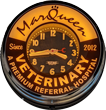See Beneath The Surface
Advanced radiology for dogs and cats.
See Beneath The Surface
Advanced radiology for dogs and cats.

Only The Best
While a thorough physical exam can tell us a lot about your pet’s health status, complex diseases and health conditions typically require more in-depth diagnostics. Advanced imaging techniques, such as digital X-rays, computed tomography (CT), and fluoroscopy, allow us to view your pet’s internal organs and structures, to help us reach an accurate diagnosis. Our board-certified veterinary radiologist has experience operating the advanced equipment needed to conduct specialized imaging, and accurately interpreting the images acquired.
Digital Radiography
Digital radiography provides the highest-quality diagnostic X-rays possible to help us evaluate your pet’s internal structures. Radiography is best suited for evaluating a pet’s bones and skeletal abnormalities, but also provides high-quality soft tissue images. Our digital radiography unit captures images in only seconds, and transmits them to a computer for immediate evaluation by our board-certified veterinary radiologist. Conditions that are commonly diagnosed using digital radiology include:
Digital Radiography
Digital radiography provides the highest-quality diagnostic X-rays possible to help us evaluate your pet’s internal structures. Radiography is best suited for evaluating a pet’s bones and skeletal abnormalities, but also provides high-quality soft tissue images. Our digital radiography unit captures images in only seconds, and transmits them to a computer for immediate evaluation by our board-certified veterinary radiologist. Conditions that are commonly diagnosed using digital radiology include:
Computed Tomography (CT)
A CT unit is a highly advanced piece of imaging equipment that is of the same quality as those used in human hospitals. By using a narrow X-ray beam aimed at a pet and quickly rotated around their body, a CT scan generates cross-sectional images that contain much more detail than digital X-ray. CT is helpful for evaluating soft tissue and bony lesions found during a clinical exam, or on digital X-rays, as it can reveal the lesion’s precise location and relationship to nearby structures. A CT scan is often used after tumor diagnosis, to determine its location and allow our surgeon to plan a surgical approach. It can also be used to check other organs for metastasis.


Fluoroscopy
Fluoroscopy provides real-time video X-ray of internal structures that allows our veterinarians to see your pet’s body functions and movement as they occur. For example, fluoroscopy allows our team to observe a pet’s esophageal motility as food is swallowed and travels to the stomach. Instead of a single, stationary X-ray image, veterinarians are able to observe body functions for abnormalities. Fluoroscopy is often used to observe gastrointestinal movement, or to guide placement of surgical devices, such as tracheal stents or blood vessel occluding devices.

Computed Tomography (CT)
A CT unit is a highly advanced piece of imaging equipment that is of the same quality as those used in human hospitals. By using a narrow X-ray beam aimed at a pet and quickly rotated around their body, a CT scan generates cross-sectional images that contain much more detail than digital X-ray. CT is helpful for evaluating soft tissue and bony lesions found during a clinical exam, or on digital X-rays, as it can reveal the lesion’s precise location and relationship to nearby structures. A CT scan is often used after tumor diagnosis, to determine its location and allow our surgeon to plan a surgical approach. It can also be used to check other organs for metastasis.

Fluoroscopy
Fluoroscopy provides real-time video X-ray of internal structures that allows our veterinarians to see your pet’s body functions and movement as they occur. For example, fluoroscopy allows our team to observe a pet’s esophageal motility as food is swallowed and travels to the stomach. Instead of a single, stationary X-ray image, veterinarians are able to observe body functions for abnormalities. Fluoroscopy is often used to observe gastrointestinal movement, or to guide placement of surgical devices, such as tracheal stents or blood vessel occluding devices.
